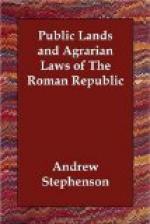To accomplish such an object as this, it was not enough to destroy and make desolate, it became necessary to repopulate the waste places and rebuild that which had been torn down. Roman citizens had to be sent as colonists into the desolate regions. Sulla, accordingly, undertook to carry out his plans of colonization, the grandest and most comprehensive which Rome had ever seen, and which indeed have had no parallel in history till the settlement of the north of Ireland by Cromwell and William III. The arrangements as to the property of the Italian soil placed at the disposal of Sulla[7] all the Roman domain lands which had been placed in usufruct to the allied communities, and which now reverted to the Roman government. It also placed at his disposal all the confiscated territories of the communities incurring punishment. Upon these territories he established military colonies, and thus obtained a three-fold result.[8] He remunerated his soldiers for the faithful service rendered him in long years of toil and danger. He repeopled the regions desolated by war (except Samnium). He provided a military protection for himself and the new constitution which he established.
Most of his new settlements were directed to Etruria, Faesulae and Arretium being among the number; others, to Latium[9] and Campania, where Praeneste and Pompeii became Sullan colonies. A great part of these colonies were, after the Gracchan manner, merely grafted upon town-communities already existing. The comprehensiveness of these settlements may be seen in this fact that 20,000 allotments were[10] made in different parts of Italy. Notwithstanding this vast disposal of territory, Sulla gave lands to the temple of Diana at Mt. Tifata, while the territory of Volaterrae and Arretium remained undisturbed. He also revived the old plan of occupation which had been legally forbidden in the year 118. Many of Sulla’s intimate friends availed themselves of this method of becoming masters of large estates.
[Footnote 1: App., Bell Civ., I, 94-100; Livy, Epit., 89. Plutarch, Life of Sulla.]
[Footnote 2: Ihne, V, 391.]
[Footnote 3: Momm., III, 428, note. See article on Sulla, in Brittannica.]
[Footnote 4: Momm., III, 401.]
[Footnote 5: Momm., III, 429; Ihne, V, 392; Long.]
[Footnote 6: Momm., III, 429.]
[Footnote 7: Momm., loc. cit.; Ihne, V, 391-395.]
[Footnote 8: Momm., III, 429.]
[Footnote 9: Momm., III, 430; Marquardt u. Momm., Roem. Alter., IV, 111, totam Italiam suis praesidiis obsidere atque ocupare; Cicero, De Leg. Agr., 2, 28, 75.]
[Footnote 10: App., I, 100; Cicero, De Legibus Agrariis, II, 28, 78; Ihne, V, 394; Marquardt u. Momm., IV, 111; Zumpt, Comm. Epigr., 242-246; Cicero, Ad Att., I, 19, 4: “Volaterranos et Arretinos, quorum agrum Sulla publicarat.”]




